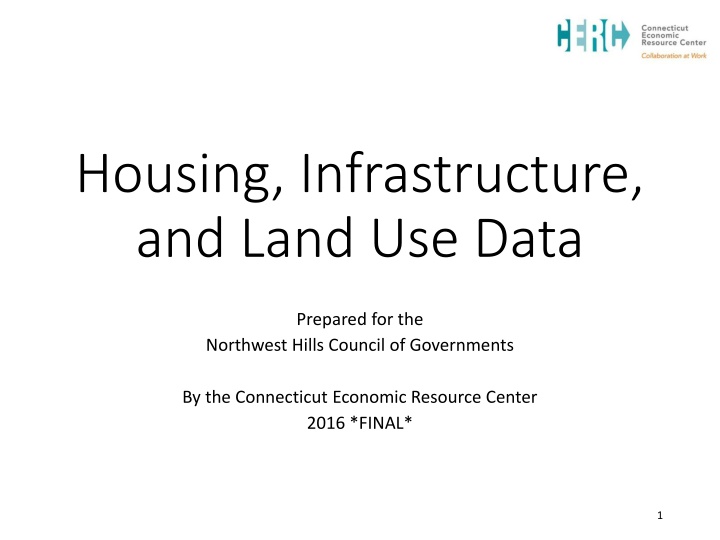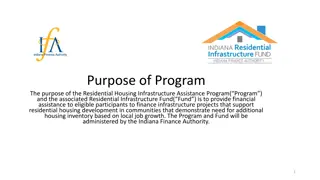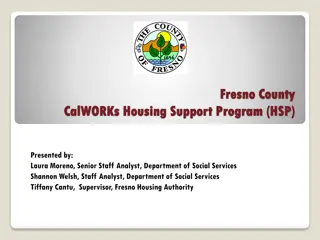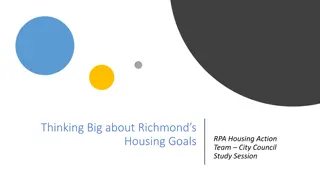Housing, Infrastructure, and Land Use Data in Northwest Hills Region
Analysis of housing units, vacancy rates, tenure, and household size in the Northwest Hills region from 2000 to 2014, showing trends in occupancy rates, renter-occupation rates, and changes in household sizes across various towns in the region.
Download Presentation

Please find below an Image/Link to download the presentation.
The content on the website is provided AS IS for your information and personal use only. It may not be sold, licensed, or shared on other websites without obtaining consent from the author.If you encounter any issues during the download, it is possible that the publisher has removed the file from their server.
You are allowed to download the files provided on this website for personal or commercial use, subject to the condition that they are used lawfully. All files are the property of their respective owners.
The content on the website is provided AS IS for your information and personal use only. It may not be sold, licensed, or shared on other websites without obtaining consent from the author.
E N D
Presentation Transcript
Housing, Infrastructure, and Land Use Data Prepared for the Northwest Hills Council of Governments By the Connecticut Economic Resource Center 2016 *FINAL* 1
Housing Units by Vacancy and Tenure Housing Units by Vacancy and Tenure The total number of housing units in the NHCOG region has increased by over 11% from 2000-2014, which is 3.8 percentage points more than housing increased statewide All towns in the region had an increase in housing during this time period In 2014, 83% of housing units in the region were occupied (versus vacant), lower than the state average of 91% Salisbury had the lowest occupancy rate (60.5%), while Burlington had the highest (95.5%) 14 towns had occupancy rates lower than the regional rate Renters represented 32.7% of occupied units in the state but only 23.6% of occupied units in the region Winchester (39.4%), Kent (35.6%), and Torrington (32.8%) had renter-occupation rates higher than the state, while Canaan (29.9%), Norfolk (27.4%), and Salisbury (26.8%) had rates between the state and the region Harwinton had the highest rate of owner-occupied properties in the region 2
Housing Units by Vacancy (2014) Housing Units by Vacancy (2014) By State, Region, and Town By State, Region, and Town 100% 90% 80% 70% 60% 50% 40% 30% 20% 10% 0% Occupied Vacant 3 Source: American Community Survey
Housing Units by Tenure (2014) Housing Units by Tenure (2014) By State, Region, and Town By State, Region, and Town 100% 90% 80% 70% 60% 50% 40% 30% 20% 10% 0% Owner-occupied Renter-occupied 4 Source: American Community Survey
Households by Size Households by Size The number of households in the region increased 5% from 2000-2014 9 towns had a smaller than 5% increase in households during this time, including four towns that saw a decrease (Kent, North Canaan, Norfolk, Salisbury) Single resident households represented 28% of households Single resident households were the largest proportion of town households in Sharon (36.6%) and the smallest proportion of town households in Hartland (13.1%) 5
Households by Size (2014) Households by Size (2014) By Town By Town 100% 90% 80% 70% 60% 50% 40% 30% 20% 10% 0% 1 person 2 people 3-4 people 5-6 people 7 or more people 6 Source: American Community Survey
New Housing Permits New Housing Permits The total number of annual housing permits issued for the region decreased from 431 permits in 2000 to 111 permits in 2014, a 74% drop The decrease in number of permits began before the Great Recession and the housing crisis The largest one year drop in permits occurred from 2005-2006 All towns in the region had an overall decrease in permits from 2000-2014, ranging from a drop of 2 permits in 4 towns (Canaan, Cornwall, Norfolk, and Washington) to a decrease of 64 permits in Torrington The largest percentage decrease was in North Canaan, which did not have any permits issued in either 2013 or 2014 7
New Housing Permits (2014) New Housing Permits (2014) By Region By Region 80% Percent change in annual housing permits issued 60% 40% 20% 0% -20% -40% -60% 2001 2002 2003 2004 2005 2006 2007 2008 2009 2010 2011 2012 2013 2014 Connecticut Northwest Hills 8 Source: CT DECD
Households That Spent More Than Households That Spent More Than 30% of Income on Housing 30% of Income on Housing In 2014, 36.5% of the region s households (in both owner- and renter-occupied units) spent more than 30% of income on housing costs This is a slight decrease from 2010, when 37.8% of households spent more than 30% of income on housing 39% of state residents spent more than 30% of their income on housing in 2014, consistent with 2010, while 35% of U.S. households spent more than 30% of their income on rent in 2014, an increase from 2010 Only in three towns did fewer that 33% of households spend more than 30% of income on housing (Barkhamsted, 29%; Harwinton, 27%, and Hartland, 23%) Kent and Washington had the highest percentage (44%) of households spending more than 30% of income on housing A larger share of renters paid more than 30% of their income on rent in the region in 2014 than owners did, similar to the pattern in the state and nation However, the difference was only 8.6 percentage points in the region compared to 16.3 and 20.9 percentage point differences in the state and nation, respectively 9
Households That Spent More Than Households That Spent More Than 30% of Income on Housing (2014) 30% of Income on Housing (2014) By Town By Town 45% 40% 35% 30% 25% 20% 15% 10% 5% 0% 10 Source: American Community Survey
Change in Housing Costs Change in Housing Costs Real monthly median housing costs have slightly decreased in the state, from $1,468 in 2009 to $1,410 in 2014, in inflation-adjusted dollars During this time, the variation in monthly median housing costs by town has decreased the difference in cost between the town with the most and least expensive housing dropped from $1,420 in 2009 to $828 in 2014 15 towns had a decrease in monthly median housing costs during this period In 2014, Winchester had the least expensive average monthly housing costs ($1,087) and Burlington had the highest ($1,915) 11
Change in Housing Costs Change in Housing Costs By Town By Town $3,000 Monthly Median Housing Costs (2014 dollars) $2,500 $2,000 $1,500 $1,000 $500 $0 2009 2010 2011 2012 2013 2014 Barkhamsted Burlington Canaan Colebrook Cornwall Goshen Hartland Harwinton Kent Litchfield Morris New Hartford Norfolk North Canaan Roxbury Salisbury Sharon Torrington Warren Washington Winchester 12 Source: American Community Survey
Median Home Sales Price Median Home Sales Price Median home sale price for single family homes decreased by $15,000 (-6%) in the state from 2009- 2013 Three towns (Colebrook, Morris, and Warren) had an increase in median single family home sales price New Hartford had an increase in median home sales price comparing 2009 to 2012 (and no homes reported sold in 2013) The biggest decrease in sales price was in Roxbury, which saw median price decrease by $347,000 13
Median Home Sales Price Median Home Sales Price By Town By Town 1,000,000 900,000 800,000 700,000 600,000 500,000 400,000 300,000 200,000 100,000 - 2009 2010 2011 2012 2013 14 Source: CT OPM
Developed and Undeveloped Land Developed and Undeveloped Land 8.1% of the region s land was developed in 2006, an increase from 7.8% in 1995 The state s developed land increased from 17.8% to 19.0% during that time Developed land represented more than 10% of total land in three towns: Burlington (11.3%), Winchester (11.9%), and Torrington (22.6%) Burlington and Torrington also had the greatest percentage point increase in developed land from 1995- 2006 15
Developed and Undeveloped Land Developed and Undeveloped Land By Town By Town 100% 90% 80% 70% 60% 50% 40% 30% 20% 10% 0% Developed Other 16 Source: UCONN CLEAR
Conserved Land Conserved Land Approximately 19% of region has been identified as conserved within towns Plans of Conservation and Development (POCD) or other planning documents 17
Conserved Land Conserved Land By Town By Town Percent of land identified as conserved 60% 50% 40% 30% 20% 10% 0% 18 Note: See Excel spreadsheet for definition of conserved, relevant years, and sources of data by town.
Aging Population Supports Aging Population Supports 27% of the region s population aged 65 or older lives alone, similar to the share of the state population of this age group living alone (28.2%) Slightly more than half of the region s and the state s 65+ population lives with a spouse, while the remainder live with a parent, with other relatives, or with nonfamily Warren had the greatest percentage of 65+ living with spouses (78.6%), while Canaan had the smallest (47.8%) More than 50% of householders aged 65+ in 5 towns (Canaan, Colebrook, Kent, Roxbury, and Salisbury) had gross rent that was more than 35% of their income The most prevalent type of disability in the region is ambulatory difficulties, which are experienced by more than 35% of the region s 65+ population and 41% of the state s 65+ population 19
Living Arrangements for Population Living Arrangements for Population Over Age 65 (2014) Over Age 65 (2014) By State, Region, and Town By State, Region, and Town 100% 90% 80% 70% 60% 50% 40% 30% 20% 10% 0% Living alone Living with spouse Living with parent(s) Living with other relative(s) Living with nonfamily 20 Source: American Community Survey
Number of Households with Gross Rent Number of Households with Gross Rent More Than 35% of Income (2014) More Than 35% of Income (2014) By Town By Town 1,000 Number of households (householders over 65 only) 900 800 700 600 500 400 300 200 100 - Gross rent below 35% of income Gross rent 35% or more of income Calculation was unavailable 21 Source: American Community Survey
Population with a Disability (2014) Population with a Disability (2014) By Town By Town Percentage of population over 65 years of age 30% 25% 20% 15% 10% 5% 0% Hearing difficulty Vision difficulty Cognitive difficulty Ambulatory difficulty Self-care difficulty Independent living difficulty 22 Source: American Community Survey
Single Single- - versus Multi versus Multi- -Family Housing Family Housing Most households in the region (78.4%) occupy single-family homes This is higher than the percentage of households in single-family homes in the state (64.6%) Only Torrington and Winchester have fewer than 75% of households in single-family homes 23
Single Single- - versus Multi versus Multi- -Family Housing (2014) Family Housing (2014) By State, Region, and Town By State, Region, and Town 100% 90% 80% 70% 60% 50% 40% 30% 20% 10% 0% Single-family Multi-family (2-9 units) Multi-family (10+ units) Mobile home, boat, etc. 24 Source: American Community Survey























